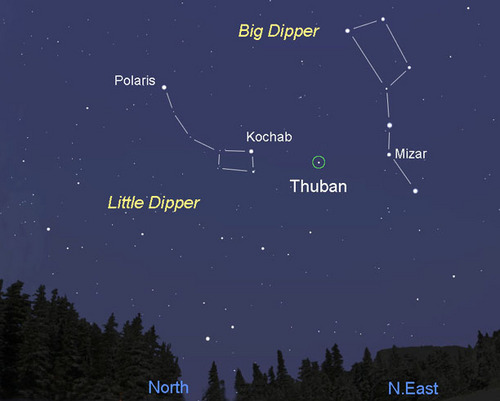
Some 5,000 years ago, Thuban (Alpha Draconis)—apparent magnitude 3.7—was the North Star.
Thuban is not a particularly bright star, but it holds a special place in the hearts of stargazers. That’s because Thuban was the Pole Star some 5,000 years ago, when the Egyptians were building the pyramids. Nowadays, Thuban is a relatively inconspicuous star in the constellation Draco the Dragon.
The Great Pyramid in Egypt has “air shafts.” One of these air shafts follows a crooked course through the Great Pyramid, so you couldn’t have sighted stars through it. To this day, the purpose of these passageways inside the Great Pyramid isn’t clear, although they might have been connected to rituals associated with the king’s ascension to the heavens. Whatever their purpose, the Great Pyramid of Giza reveals that its builders knew the starry skies intimately. They surely knew Thuban was their Pole Star, the point around which the heavens appeared to turn.
The 26,000-year precession cycle of Earth causes the north celestial pole to move counter-clockwise relative to the backdrop stars. Whichever star is closest to the north celestial pole is the Pole Star.
Earth never changes its axial tilt, but its axis does point out at different pole stars. Many compare this movement of Earth to the wobble of a spinning top before it falls.
Indeed, Thuban at times made a better pole star than our modern Polaris. Various sources claim that Thuban almost exactly pinpointed the position of the north celestial pole in the year 2787 B.C.
Meanwhile, our modern Polaris—which many centuries ago was an ordinary star known by the name Phoenice—won’t match Thuban’s precision when it most closely aligns with the north celestial pole on March 24, 2100. Polaris will be 27’09” from the north celestial pole at that time (a little less than the angular diameter of the moon when at its farthest from Earth), according to the computational wizard Jean Meeus.
Advertisements Like this:Like Loading... Related




